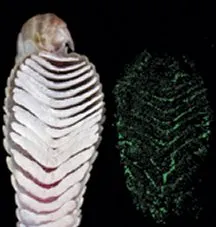So strong is the stickiness of some geckos’ feet that the lizards can hang from a ceiling by a single toe. Despite that clinginess, the forest of adhesive fibers on the underside of each toe stays nearly dirtfree without grooming or washing.

Now, researchers say they’ve figured out the secret. Moreover, because dirt typically weakens adhesive bonds, the findings could inspire improved surface-attachment schemes for mountain climbers and robots.
In the new study, Wendy R. Hansen and Kellar Autumn coated the feet of live Tokay geckos with ceramic microspheres. This mock dirt counteracted the weak van der Waals forces that usually sum into a lizard’s tenacious grip on surfaces.
Using glass as a model surface, the researchers determined the foot-glass attraction as the lizards took a series of steps. With each step, the grip became stronger, indicating that microspheres were being shed.
In other tests, the researchers simulated steps using arrays of foot fibers removed from gecko toes and dusted with the microspheres. These trials also showed that gecko feet are “self-cleaning,” Hansen, now at the University of California, Berkeley, and Autumn of Lewis & Clark College in Portland, Ore., report in the Jan. 11 Proceedings of the National Academy of Sciences.
To find out how gecko feet clean themselves, the team considered the van der Waals forces that a surface, such as a wall, exerts on a microsphere. They then compared that attraction with the hold on the particle by toe fibers. Using simplified geometric models that represent the ends of the fibers as shallow cups or flexible strips, the scientists calculated that from 26 to 59 of the fibers would have to cling to each microsphere to keep it from sticking to the wall as the gecko steps away.
Yet in most cases, “when you look under an electron microscope, you don’t observe that many [fibers] actually attached to a single dirt particle,” Autumn notes. Hence, when the fibers and the surface compete for a dirt particle, the surface usually wins.
This new work is “potentially important for a fundamental understanding of adhesion processes and for biomimetic mechanical systems,” such as walking robots, comments Jacob N. Israelachvili of the University of California, Santa Barbara.
However, this picture of competition for dirt between surface and fiber forces is probably incomplete, others caution. Manoj K. Chaudhury of Lehigh University in Bethlehem, Pa., for instance, urges a reexamination of the proposed mechanism of self-cleaning using more-sophisticated models of the forces and geometries involved.
Gecko feet have already inspired new adhesives (SN: 6/7/03, p. 356: Caught on Tape: Gecko-inspired adhesive is superstrong), Autumn notes. If they can self-clean, such adhesives might even prove useful in rock climbing or for making geckolike Mars rovers, he adds.







